The sensory table is one of the most beloved areas in any preschool classroom. Many students come to school without having had the opportunity for purposeful sensory play at home. It can be daunting for parents to have an entire bin of sand or rice in their home. Often, a preschooler’s first experiences with sensory materials in a container are in the preschool classroom. Here are loads of sensory table ideas to use in the classroom or home!
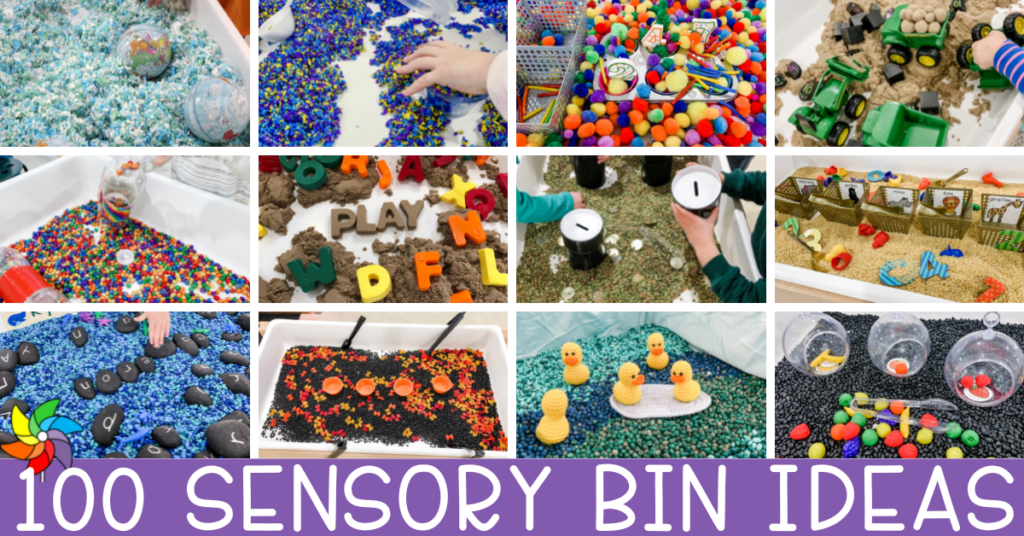
Why Sensory Play?
Sensory play is an integral part of early childhood education. While playing with the sand, rice, or whatever else is in the sensory table is fun, it is also highly educational. At the sensory table, students are learning:
- Mathematical Skills: Students are experimenting with volume, a higher level concept, when they pour from various containers into larger or smaller containers. Students can observe how a short and wide container holds as much as a tall and thin container. Children naturally practice sorting when they have different items at the table. They make different shapes and practice early geometry in a 3-D, hands-on fashion!
- Language Development: Preschoolers at the sensory table often develop elaborate imaginary play and talk about it to their friends. Conversations around the sensory table use descriptive language, such as, “Please hand me the purple thing with holes in it.” “That’s called a sieve!” “Ok, please, can I have the purple sieve?” They also have conversations about what they are creating, what they feel, and sometimes even unrelated chats. All of these things are great for conversational language development!
- Science: When rice pours through a funnel, students explore physical science, such as gravity. They can play with buoyancy when they test objects that sink or float. Toy animals in different materials spark conversations about biomes and habitats.
- Creativity: Open-ended play is essential. There’s no beginning or end to the play, and no set directive like in a board game. The students are there to play, experiment, and let their creativity run wild.
- Literacy: Practicing literacy skills in a fun medium like a sensory bin helps build more connections. Students can see a letter, touch it, draw it, cover it up, compare it to other letters…all while playing and having fun!
While the sensory table is a lot of fun for little ones, it is important to take the opportunity to change up the material and the themes to maintain interest and work on different skills. These sensory table ideas are simply suggestions – the only limit is imagination!
Aquarium Gravel
Aquarium gravel is a great sensory substance. It comes in nearly any color, is inexpensive, and has an excellent weight. It even comes in bright neon colors that possibly glow under a black light for an out-of-this-world space center!
- Add smooth river rocks with letters written on them. Add name cards and students can find the letters in their names!
- Sea shells are great for comparing sizes, shapes, and colors and scooping and pouring.
Beans
Beans are an inexpensive sensory superstar! It’s easy to find large quantities of dried beans in many varieties. Black beans provide an excellent backdrop for brightly colored additions and themes like outer space. Red and brown beans provide a lovely natural element. Lighter-colored beans are easy to dye to fit whatever theme is needed.
Beans with colors to “dye” for!
Dying dried beans is similar to coloring any other sensory material. First, put the beans in a zip-top bag. Add a few drops of rubbing alcohol and some liquid watercolor or food coloring. Gel food colors do end up with brighter results, but they do take longer to dry. Mix the beans and food coloring thoroughly. Empty the bag onto parchment-lined cookie sheets to dry for 24-48 hours before use. Super easy!
Here are some more ideas for beans in the sensory table:
- This darling Very Hungry Caterpillar bin uses black beans as a backdrop for colorful pieces. (Idea from Rubber Boots and Elf Shoes)
- Sticking with that Eric Carle theme, this Brown Bear Brown Bear What Do You See bin from Childhood 101 uses rainbow-dyed beans for extra fun!
Chickpeas
Chickpeas have a nice weight to them. The weight helps give the students some heavy work when using them. Heavy work doesn’t necessarily mean that it has to be something that an adult would consider “heavy,” instead, it is any activity that pushes or pulls on the body and gives some resistance. One water bottle full of chickpeas is a considerable weight compared to the average preschooler’s! This weight provides proprioceptive input to the muscles and joints, which aids the student with greater awareness of their body and better control. This awareness can be beneficial before a writing or cutting activity since sensory work focuses on those smaller muscles!
These rainbow chickpeas are amazing for so many reasons. You can’t buy them rainbow-colored, of course. But thankfully, Dyan at “AndNextComesL” has some fantastic tips on how to make your own!
Kinetic Sand
Kinetic sand is such a unique substance! It’s regular sand coated with silicone oil. When squeezed together or pressed with a stamp, it holds shape but falls like dry sand when the pressure is released. Because of the unique coating, Kinetic sand doesn’t need water to maintain a form and never dries out.
While nothing is more effective than the real thing, there are dozens of recipes online to make DIY kinetic sand.
Still have little ones that mouth everything? Try this Taste-Safe Sand recipe from A Little Pinch of Perfect.
Lentils
Lentils are small, disc-shaped legumes popular in many different cultures. They most commonly come in red, green, and brown. Also, they make a LOVELY sensory material! The possibilities for scooping, digging, pouring, molding, filling, sprinkling, and pattern making are endless. Lentils create an excellent base for a tray full of exciting textures, colors, and sound (when sprinkled) and hold things in place well.
Noodles
Noodles are perhaps one of the most inexpensive ways to add variety to the sensory table. It doesn’t cost much, and there are many different shapes and styles. Dried pasta won’t spoil, which means students can reuse it over and over again. It can be dyed, broken, scooped, and poured. Some pasta shapes can even be threaded on pipe cleaners or yarn!
Want to experiment with some cooked noodles? This rainbow-dyed spaghetti idea from Parenting Chaos is a lot of fun!
Oatmeal
Oatmeal might seem like a messy choice for this list of sensory table ideas, but it’s also safe for younger students (or those who love to put everything in their mouths) and is easy to come by. It’s great for dumping and scooping, smells like breakfast, and can come in different textures – steel cut, whole rolled, or even instant.
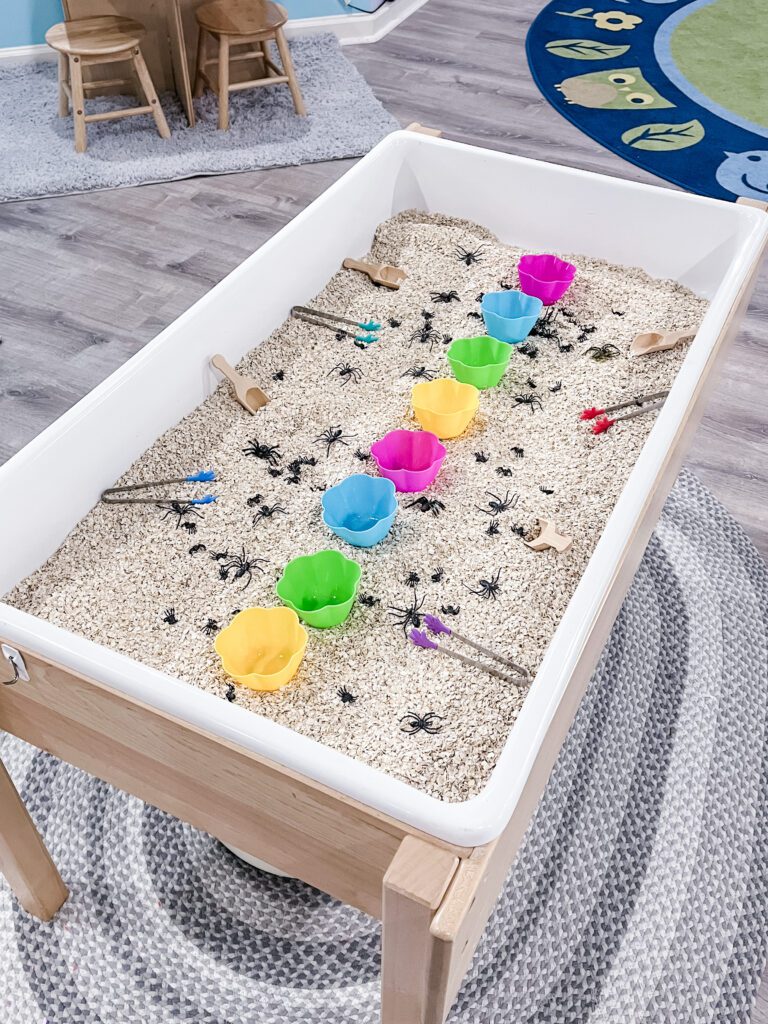
While oatmeal is, well, oatmeal colored, adding glitter or paper confetti can add to the fun (but not the taste-safe factor)!
Pluffle
Pluffle is a material designed by Playfoam, an educational Insights company. Made of soft foam shreds with a hint of sparkle and in a variety of bright, child-pleasing colors, Pluffle is a fantastic addition to the sensory repertoire. Read more about Pluffle here!
Pom-Poms
Pom-Poms make a fantastic introductory sensory bin material. Here’s why!
- They are quiet. Dumping and filling are great, but some heavier materials are pretty noisy!
- They don’t roll far. Because of their soft nature, the pom-poms tend to stay in the sensory area, even if they escape the table.
- They are easy to clean up. Again, because pom-poms don’t spread everywhere, they are very simple for young preschoolers to clean up.
- They are colorful. Preschoolers love bright colors – this is no exception!
- They are NOT tasty looking. Unlike some food sensory bins or play dough, nothing is appealing about putting a pom-pom in one’s mouth!
- They are inexpensive. You can order a ton of pom-poms online.
- They are lightweight, so the sensory bin isn’t hard to move if the room setup isn’t quite right.
On top of all that, pom-poms come in various colors, which lends itself perfectly to the fact that one of the very first preschool skills is sorting by color and identifying colors!
Pumpkin Seeds
Pumpkins are often linked with fall, so it is a perfect time to bring the season into the preschool classroom! Students who carve pumpkins at home can connect the activity at home with this sensory table.
Using authentic materials, such as pumpkin seeds, in the sensory table helps to tie together a theme or season throughout the classroom. And don’t worry – you can purchase already dried, salt-free pumpkin seeds directly online! No need to scrape dozens of pumpkins, rinse the seeds, and cook them. Just open the package and get ready to have some sensory table fun!
How to Dye Pumpkin Seeds
- Put the seeds in a seal-top bag with a splash of liquid watercolor and shake well.
- Pour the bag onto a covered surface and spread the seeds out to dry overnight.
- Repeat with different colors for an entire rainbow, or go with an orange, black, and natural theme.
Rice
Why rice? It’s incredibly versatile. It doesn’t leave any residue on tiny fingers. The teacher can color it with food dye; it is easily swept up and is typically not an allergen. It’s also inexpensive – large bags sell for just a few dollars.
Rice also takes scents well. Use spices or cooking extracts to give the table a little boost – just add the liquids scents when you dye the rice. The dried spices can be mixed right in!
- One great idea for dried spices is this gingerbread scented rice bin from Childhood 101.
- Use green-dyed rice as a backdrop for this fun spring and Insects sensory bin from Fun with Mama.
Shredded Paper
Shredded paper is a cheap, easy, and readily available sensory bin filler. Recycle paper and use it directly from the shredder or purchase small bags of decorative shredded paper. A little goes a LONG way if you buy the decorative variety!
Shredded paper is also available at pet stores as bedding for small animals. These come in all colors, are pre-shredded, and are usually made from recycled materials. Win-win-win!
Snow
A snow-themed sensory bin comes with several options. First, there’s the real thing. Icy clean snow straight from the outdoors. Choosing that route does have benefits – it’s natural, free, and the kids love it. However, mittens or gloves are needed, and the teachers must watch children closely so they do not get frostbite!
Insta-snow is a non-toxic polymer, similar to the material used in disposable baby diapers. It absorbs the water and fluffs up to look like real snow. It is relatively mess-free, always a plus! Also, it can be frozen and molded just like the real thing. While non-toxic, it is best suited for students old enough not to put it in their mouths.
Finally, clear gravel, crystals, vase filler, and acrylic cubes can substitute for the frosty filler. It isn’t cold, but it is still great for winter play.
Soil
While it might seem strange to suggest soil as one of the sensory table ideas, topsoil (not potting soil with added chemicals) or regular old dirt from the garden makes an inexpensive and intriguing sensory bin filler. Think of all the mud pies! Involve the students in digging it up and bringing it to the sensory table. Add silk flowers from the dollar store or some fake worms, and students contentedly dig for hours. Try adding construction vehicles, larger rocks, and twigs for some great building and demolition play for a construction unit! This sensory table idea is one that can be moved outdoors without fear – perhaps a mud pie café in one corner of the playground could be a permanent fixture.
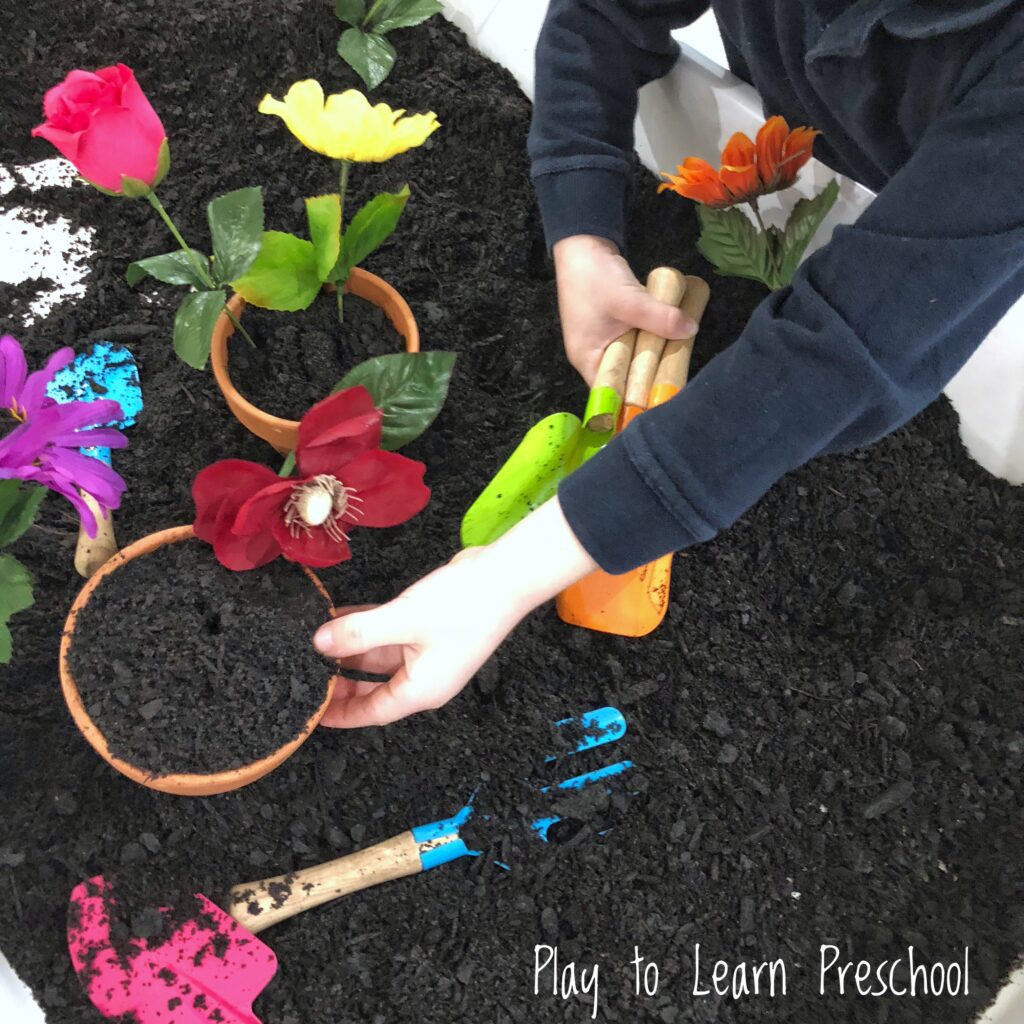
Water
Some good clean fun- kids love playing with water and bubbles, so why not combine them in the sensory bin? This is easily one of the simplest of all sensory table ideas.
How to make a soapy water sensory bin:
- Add a squirt of Dawn dish detergent or tear-free baby shampoo into the sensory bin.
- Turn on the hose.
- Fill the sensory bin with the full force water from the hose.
- Watch the bubbles form!
- Add plastic toys, buckets, whisks, cups, funnels, and more!
- Play and enjoy. Refill as desired.
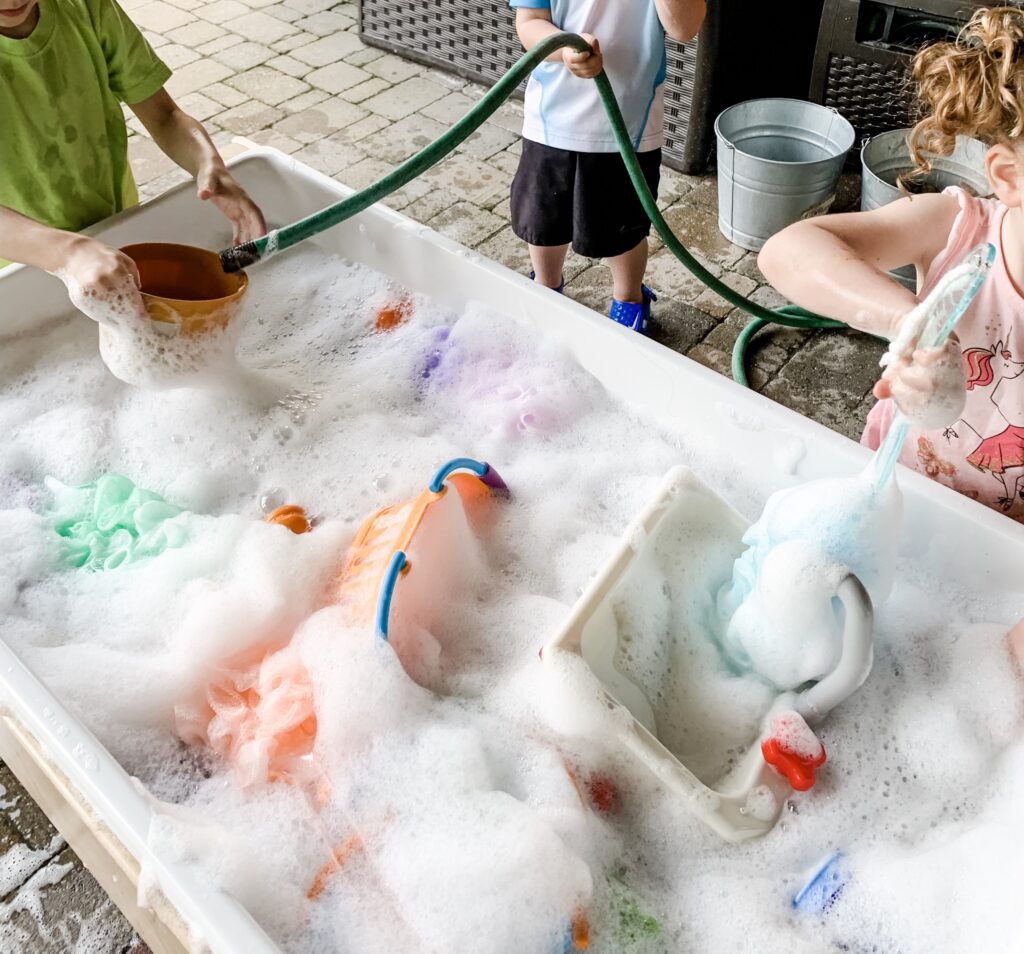
Here are some other great water sensory bins
- Explore magnetism with this fun Water and Magnets sensory bin from AndNextComesL
- Splash into outer space play with this amazing Glowing Galaxy Water Bin from Fun-a-Day
- Add toy cars, scrub brushes and squirt bottles for a car wash-themed bin!
- Bathtime for Babies! Use plastic baby dolls, baby bathtubs, soap, water, and washcloths, and give those babies a bath!
Water Beads
Water beads (also called Orbeez or vase filler) come in many different color assortments. They are tiny dry beads that need to be soaked in water overnight. Once saturated with water, they make for a slippery, fun material that pours, scoops, and bounces. Read more about them here!
This is one of those sensory table ideas best reserved for older students. While non-toxic, the water beads can create a health situation if ingested or put in a nose or ear. Even with older students, supervision is required. If you have younger students, try this instead!
Try the water beads with these fun variations:
- Make a water bead pond with a wading pool, rubber ducks, plastic fish, and more!
- Shark-obsessed preschoolers? Try this shark-themed letters and numbers bin from Living Montessori Now.
- Put the water beads into a clear plastic bin and put them on the light table for a fun glowing experience.
Important Message on Safety!
As a caregiver, you must decide what you feel is safe for your children. Contact a pediatrician for guidance if unsure about an activity’s safety/age appropriateness. All activities shared are to be performed with adult supervision. Appropriate and reasonable caution should be used when activities call for the use of materials that could potentially be harmful or items that could present a choking risk (small items) or a drowning risk (water activities), and with introducing a new food/ingredient to a child (allergies). Observe caution and safety at all times.

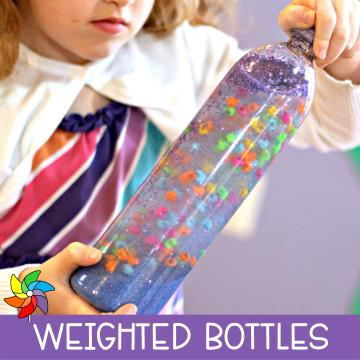
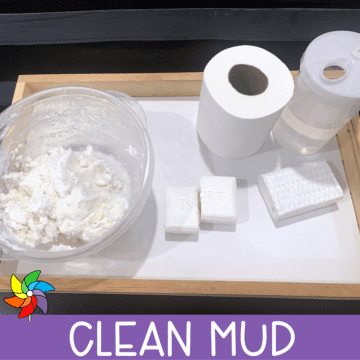
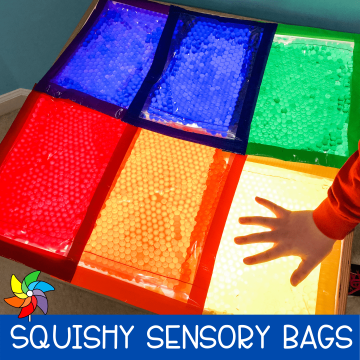
Once we know the students and if they are “mouthers” or can handle smaller items, we have used
Corn, a huge bucket of all kinds of buttons, mini erasers that go with our theme, pirate or Leprechaun gold coins with treasure chests and something to hind them under ( like rice or shredded paper). We have used covers to markers that have dried out. Adds lots of color to the bin and we have used table scatter too.
Love sensory table or trays!!!